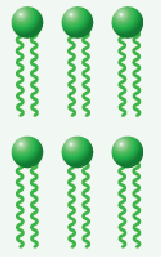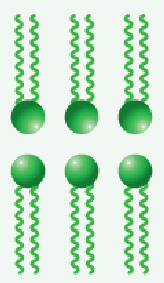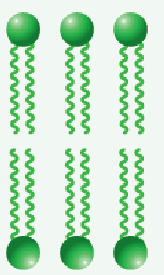
EBK GENERAL, ORGANIC, AND BIOLOGICAL CH
7th Edition
ISBN: 8220100853180
Author: STOKER
Publisher: CENGAGE L
expand_more
expand_more
format_list_bulleted
Concept explainers
Textbook Question
Chapter 19.10, Problem 1QQ
Which of the following is a correct representation for the structure of a lipid bilayer?



- a. no correct response
Expert Solution & Answer
Want to see the full answer?
Check out a sample textbook solution
Students have asked these similar questions
Which of the following correctly describes the structure of the phospholipid bilayer in plasma
membranes?
The polar hydrophilic groups of each leaflet face outward, toward the aqueous
environment on either side of the membrane.
A
The non-polar hydrophobic groups of each leaflet face inward, toward each other.
The non-polar hydrophilic groups of each leaflet face outward, toward the aqueous
environment on either side of the membrane.
B
The polar hydrophobic groups of each leaflet face inward, toward each other.
The polar hydrophilic groups of each leaflet face inward, toward each each other.
The non-polar hydrophobic groups of each leaflet face outward, toward the aqueous
environment on either side of the membrane.
The non-polar hydrophilic groups of each leaflet face inward, toward each each other.
The polar hydrophobic groups of each leaflet face outward, toward the aqueous
environment on either side of the membrane.
Choose all that aplly that are TRUE for the lipid bilayer:Negative mark is given to incorrect answer(s).
a.
The polar head groups of the bilayer are positively charged.
b.
Individual lipid molecules in one face (monolayer) of the bilayer cannot diffuse (flip-flop) to the other monolayer and must be catalyzed by a lipid transporter called flippase.
c.
The bilayer is stabilized by covalent bonds between neighbouring phospholipid molecules.
d.
Polar, but uncharged, compounds readily diffuse across the bilayer.
e.
Individual lipid molecules are free to diffuse laterally on the surface of the bilayer.
Ms. Sassa, a biology professor, wanted to demonstrate to her students the
applicability of a dialyzing membrane (DM) as a model for the cell membrane by
enclosing an aqueous solution in a DM bag and immersing in a beaker containing a
different solution. Substances available which are permeable to the DM include 0.02 M
NaCl, 0.03 M glucose, and 0.01 M glucose. The only substance available which is
completely impermeable to the DM is the 0.01 M lactose. Using the substances given
and materials such as a beaker, stirring rod, and string, draw ONLY ONE set-up that
can be demonstrated by Ms. Sassa that will satisfy ALL of the following conditions:
a. No solute will exhibit a net diffusion out of the cell.
b. Glucose will exhibit a net diffusion into the cell.
c. NaCl will exhibit a zero net movement.
d. No net movement of lactose from the inside to outside of the cell.
Make sure to label properly the substance inside the beaker and inside the DM bag.
Chapter 19 Solutions
EBK GENERAL, ORGANIC, AND BIOLOGICAL CH
Ch. 19.1 - Prob. 1QQCh. 19.1 - Which of the following is not a biochemical...Ch. 19.1 - The saponifiable/nonsaponifiable classification...Ch. 19.2 - Prob. 1QQCh. 19.2 - Prob. 2QQCh. 19.2 - Prob. 3QQCh. 19.2 - Prob. 4QQCh. 19.3 - Prob. 1QQCh. 19.3 - Prob. 2QQCh. 19.4 - How many structural subunits are present in the...
Ch. 19.4 - Prob. 2QQCh. 19.4 - How many different simple triglyceride molecules...Ch. 19.4 - Prob. 4QQCh. 19.4 - Prob. 5QQCh. 19.4 - Unsaturated fatty acid residues are structural...Ch. 19.5 - Prob. 1QQCh. 19.5 - Prob. 2QQCh. 19.5 - Prob. 3QQCh. 19.6 - Prob. 1QQCh. 19.6 - Prob. 2QQCh. 19.6 - Prob. 3QQCh. 19.6 - Prob. 4QQCh. 19.6 - Prob. 5QQCh. 19.6 - Prob. 6QQCh. 19.7 - Based on biological function, phospholipids are...Ch. 19.7 - Prob. 2QQCh. 19.7 - Which of the following statements about the...Ch. 19.7 - When the head and two tails structural model is...Ch. 19.7 - Prob. 5QQCh. 19.7 - Prob. 6QQCh. 19.8 - The number of structural building blocks present...Ch. 19.8 - Prob. 2QQCh. 19.9 - Prob. 1QQCh. 19.9 - Which of the following types of membrane lipids...Ch. 19.9 - Prob. 3QQCh. 19.10 - Which of the following is a correct representation...Ch. 19.10 - Prob. 2QQCh. 19.10 - Prob. 3QQCh. 19.10 - Prob. 4QQCh. 19.10 - Which of the following membrane transport...Ch. 19.11 - Which of the following statements concerning bile...Ch. 19.11 - Which of the following statements concerning...Ch. 19.12 - Prob. 1QQCh. 19.12 - Prob. 2QQCh. 19.12 - Prob. 3QQCh. 19.13 - Prob. 1QQCh. 19.13 - Aspirin reduces inflammation and fever by...Ch. 19.13 - Prob. 3QQCh. 19.14 - Prob. 1QQCh. 19.14 - Prob. 2QQCh. 19.14 - Prob. 3QQCh. 19.15 - In which of the following pairs of lipid types are...Ch. 19.15 - Prob. 2QQCh. 19.15 - Prob. 3QQCh. 19 - Indicate whether each of the following general...Ch. 19 - Indicate whether each of the following general...Ch. 19 - Would you expect lipids to be soluble or insoluble...Ch. 19 - Would you expect lipids to be soluble or insoluble...Ch. 19 - What is the biochemical function category for each...Ch. 19 - What is the biochemical function category for each...Ch. 19 - Classify each of the following fatty acids as...Ch. 19 - Classify each of the following fatty acids as...Ch. 19 - Classify each of the following fatty acids as...Ch. 19 - Classify each of the following fatty acids as...Ch. 19 - Prob. 19.11EPCh. 19 - Prob. 19.12EPCh. 19 - Prob. 19.13EPCh. 19 - Prob. 19.14EPCh. 19 - Prob. 19.15EPCh. 19 - Classify each of the fatty acids in Problem 19-14...Ch. 19 - Draw the condensed structural formula for the...Ch. 19 - Draw the condensed structural formula for the...Ch. 19 - Prob. 19.19EPCh. 19 - Using the information given in Table 19-1, assign...Ch. 19 - What is the relationship between carbon chain...Ch. 19 - What is the relationship between degree of...Ch. 19 - What structural change is associated with the...Ch. 19 - Why does the introduction of a cis-double bond...Ch. 19 - In each of the following pairs of fatty acids,...Ch. 19 - In each of the following pairs of fatty acids,...Ch. 19 - What are the four structural subunits that...Ch. 19 - Draw the general block diagram for a...Ch. 19 - Prob. 19.29EPCh. 19 - Prob. 19.30EPCh. 19 - Draw the condensed structural formula of a...Ch. 19 - Draw the condensed structural formula of a...Ch. 19 - Draw block diagram structures for the four...Ch. 19 - Draw block diagram structures for the three...Ch. 19 - Identify, by common name, fatty acids present in...Ch. 19 - Identify, by common name, fatty acids present in...Ch. 19 - Prob. 19.37EPCh. 19 - Prob. 19.38EPCh. 19 - Prob. 19.39EPCh. 19 - Prob. 19.40EPCh. 19 - Prob. 19.41EPCh. 19 - Prob. 19.42EPCh. 19 - Prob. 19.43EPCh. 19 - Prob. 19.44EPCh. 19 - Prob. 19.45EPCh. 19 - Prob. 19.46EPCh. 19 - For each of the triacylglycerol molecules in...Ch. 19 - For each of the triacylglycerol molecules in...Ch. 19 - What are the general names for the products...Ch. 19 - What additional products are formed when a...Ch. 19 - Classify each of the reaction situations in...Ch. 19 - Prob. 19.52EPCh. 19 - Draw condensed structural formulas for all...Ch. 19 - Draw condensed structural formulas for all...Ch. 19 - Prob. 19.55EPCh. 19 - Draw condensed structural formulas for all...Ch. 19 - Why can only unsaturated triacylglycerols undergo...Ch. 19 - Prob. 19.58EPCh. 19 - How many molecules of H2 will react with one...Ch. 19 - How many molecules of H2 will react with one...Ch. 19 - Prob. 19.61EPCh. 19 - Prob. 19.62EPCh. 19 - Prob. 19.63EPCh. 19 - Prob. 19.64EPCh. 19 - Prob. 19.65EPCh. 19 - Prob. 19.66EPCh. 19 - Prob. 19.67EPCh. 19 - Prob. 19.68EPCh. 19 - The following is a block diagram for a...Ch. 19 - Prob. 19.70EPCh. 19 - Prob. 19.71EPCh. 19 - Prob. 19.72EPCh. 19 - Prob. 19.73EPCh. 19 - Indicate whether each of the following statements...Ch. 19 - Based on the head and two tails model for the...Ch. 19 - Based on the head and two tails model for the...Ch. 19 - Prob. 19.77EPCh. 19 - Prob. 19.78EPCh. 19 - Prob. 19.79EPCh. 19 - Prob. 19.80EPCh. 19 - Prob. 19.81EPCh. 19 - Prob. 19.82EPCh. 19 - Prob. 19.83EPCh. 19 - Prob. 19.84EPCh. 19 - Which of the terms triacylglycerol,...Ch. 19 - Prob. 19.86EPCh. 19 - Prob. 19.87EPCh. 19 - Which of the terms triacylglycerol,...Ch. 19 - Prob. 19.89EPCh. 19 - Prob. 19.90EPCh. 19 - Prob. 19.91EPCh. 19 - Prob. 19.92EPCh. 19 - Prob. 19.93EPCh. 19 - Prob. 19.94EPCh. 19 - Prob. 19.95EPCh. 19 - Prob. 19.96EPCh. 19 - Give numerical answers to the following questions...Ch. 19 - Prob. 19.98EPCh. 19 - Prob. 19.99EPCh. 19 - Prob. 19.100EPCh. 19 - In a dietary context, what is the difference...Ch. 19 - Prob. 19.102EPCh. 19 - Prob. 19.103EPCh. 19 - Prob. 19.104EPCh. 19 - Indicate whether each of the following statements...Ch. 19 - Indicate whether each of the following statements...Ch. 19 - What is the function of unsaturation in the...Ch. 19 - Prob. 19.108EPCh. 19 - Prob. 19.109EPCh. 19 - Prob. 19.110EPCh. 19 - Prob. 19.111EPCh. 19 - Prob. 19.112EPCh. 19 - Prob. 19.113EPCh. 19 - Prob. 19.114EPCh. 19 - Prob. 19.115EPCh. 19 - Prob. 19.116EPCh. 19 - Prob. 19.117EPCh. 19 - Prob. 19.118EPCh. 19 - Prob. 19.119EPCh. 19 - Prob. 19.120EPCh. 19 - Prob. 19.121EPCh. 19 - Prob. 19.122EPCh. 19 - Prob. 19.123EPCh. 19 - Prob. 19.124EPCh. 19 - What is the medium through which bile acids are...Ch. 19 - What is the chemical composition of bile?Ch. 19 - At what location in the body are bile acids stored...Ch. 19 - Prob. 19.128EPCh. 19 - Prob. 19.129EPCh. 19 - Prob. 19.130EPCh. 19 - Prob. 19.131EPCh. 19 - Prob. 19.132EPCh. 19 - Prob. 19.133EPCh. 19 - Prob. 19.134EPCh. 19 - Prob. 19.135EPCh. 19 - Prob. 19.136EPCh. 19 - Prob. 19.137EPCh. 19 - Prob. 19.138EPCh. 19 - Draw the structure of an anabolic steroid with the...Ch. 19 - Prob. 19.140EPCh. 19 - What is the major structural difference between a...Ch. 19 - What is the major structural difference between a...Ch. 19 - Prob. 19.143EPCh. 19 - What structural feature distinguishes a...Ch. 19 - Classify each of the following types of lipids as...Ch. 19 - Classify each of the following types of lipids as...Ch. 19 - Prob. 19.147EPCh. 19 - Prob. 19.148EPCh. 19 - Prob. 19.149EPCh. 19 - Draw the condensed structural formula of a wax...Ch. 19 - Prob. 19.151EPCh. 19 - Biological waxes have a head and two tails...Ch. 19 - Which of the substance categories biological wax,...Ch. 19 - Which of the substance categories biological wax,...Ch. 19 - Prob. 19.155EPCh. 19 - Prob. 19.156EPCh. 19 - Prob. 19.157EPCh. 19 - Indicate whether or not each of the following...Ch. 19 - Prob. 19.159EPCh. 19 - Prob. 19.160EPCh. 19 - Prob. 19.161EPCh. 19 - Prob. 19.162EP
Knowledge Booster
Learn more about
Need a deep-dive on the concept behind this application? Look no further. Learn more about this topic, biology and related others by exploring similar questions and additional content below.Similar questions
- Which plasma membrane component can be either found on its surface or embedded in the membrane structure? a. protein b. cholesterol c. carbohydrate d. phospholipidarrow_forwardUsing the answer code on the right, indicate which membrane component is responsible for the function in question: 1. channel formation____________________________________ (a) lipid bilayer 2. barrier to passage of water- __________________ (b) proteins soluble substances ____________________________________ (c) carbohydrates 3. receptor sites 4. membrane fluidity 5. recognition of self 6. membrane-bound enzymes 7. structural boundary 8. carriersarrow_forwardA given substance would require active transport across a lipid bilayer into a cell if... (choose all that apply): it has an electrical charge it is a large and polar it is present at a lower concentration inside the cell it is present at a higher concentration inside the cellarrow_forward
- Most materials entering the cell pass across the cell membrane by diffusion. In general, the larger the molecule, the slower the molecule diffuses across the membrane. The graph shows the sizes of several molecules that can diffuse across a lipid bilayer. Use the bar graph to answer the following question. Which of the following is a logical prediction based on the graph shown? Size of Molecules Carbon dioxide Glucose Oxygen Water 50 100 150 200 Size (daltons) Cells contain more glucose than oxygen O B Glucose molecules must not be able to cross the cell membrane Carbon dioxide crosses the cell membrane faster than glucose O D Glucose crosses the cell membrane faster than water Moleculearrow_forwardThe image shows a lipid bilayer, with the polar heads represented by circles and the hydrophobic tails represented by lines. Arrange the fatty acids in the lipid bilayer to indicate a structure that, when incorporated into a phospholipid, would result in a more fluid membrane with a lower melting point. Be sure to insert the fatty acids into the bilayer in the correct orientation. Not all the fatty acids will be used. Answer Bankarrow_forwardPractitioners of naturopathic medicine often use “essential oils” such as lavender oil. (Note that essential refers to their essence or scent and does not imply that these substances are necessary for health.) One of the components of lavender oil is shown below. Based on its structure, could this molecule diffuse through the cell membrane of a skin cell after the oil was applied to the skin surface?arrow_forward
- Most materials entering the cell pass across the cell membrane by diffusion. In general, the larger the molecule, the slower the molecule diffuses across the membrane. The graph shows the sizes of several molecules that can diffuse across a lipid bilayer. Use the bar graph to answer the following question. Which of the following is a logical prediction based on the graph shown? Size of Molecules Carbon dioxide Glucose Oxygen Water 50 100 150 200 Size (daltons) Moleculearrow_forwardWhich of the following statements is/are incorrect? 1. The cell membrane is purely hydrophobic. 2. Glycerophospholipids have a phosphate derivative group that is known as the polar head group. 3. The individual glycerophospholipid molecules that aggregate become covalently linked to each other to form a lipid bilayer. 4. The interfacial region of a lipid bilayer is polar due to the polar head groups of the lipid molecules that make up the bilayer. O 1 and 3 O 1 only O 2 and 4 O 3 only O 4 onlyarrow_forwardLipid bilayers are said to behave like two-dimensional fluids. What does this mean? What drives the movement of lipid molecules and proteins within the bilayer? How can such movement be measured? What factors affect the degree of membrane fluidityarrow_forward
- Below is the skeletal formula of a molecule typically found in cell membranes. What type of molecule is this and how can you tell? What are the functions of this type of molecule in the plasma membrane of a cell? CH3 CH₂) (CH₂) 16 CH3 Koarrow_forwardWhich of the following choice/s will best complete the statement below: For bilayers that have a high proportion of fatty acid derivatives, adding cholesterol will most likely the fluidity of the bilayer. unsaturated; increase saturated; increase saturated; decrease O unsaturated; decreasearrow_forwardDO NOT COPY THE ANSWER FROM THE SAME QUESTION. Sassa, a biology professor, wanted to demonstrate to her students the applicability of a dialyzing membrane (DM) as a model for the cell membrane by enclosing an aqueous solution in a DM bag and immersing in a beaker containing a different solution. Substances available which are permeable to the DM include 0.02 M NaCl, 0.03 M glucose, and 0.01 M glucose. The only substance available which is completely impermeable to the DM is the 0.01 M lactose. Using the substances given and materials such as a beaker, stirring rod, and string, draw ONLY ONE set-up that can be demonstrated by Ms. Sassa that will satisfy ALL of the following conditions:a. No solute will exhibit a net diffusion out of the cell.b. Glucose will exhibit a net diffusion into the cell.c. NaCl will exhibit a zero net d. No net movement of lactose from the inside to outside of the cell. Make sure to label properly the substance inside the beaker and inside the DM bag.arrow_forward
arrow_back_ios
SEE MORE QUESTIONS
arrow_forward_ios
Recommended textbooks for you
 Concepts of BiologyBiologyISBN:9781938168116Author:Samantha Fowler, Rebecca Roush, James WisePublisher:OpenStax College
Concepts of BiologyBiologyISBN:9781938168116Author:Samantha Fowler, Rebecca Roush, James WisePublisher:OpenStax College Human Physiology: From Cells to Systems (MindTap ...BiologyISBN:9781285866932Author:Lauralee SherwoodPublisher:Cengage Learning
Human Physiology: From Cells to Systems (MindTap ...BiologyISBN:9781285866932Author:Lauralee SherwoodPublisher:Cengage Learning

Concepts of Biology
Biology
ISBN:9781938168116
Author:Samantha Fowler, Rebecca Roush, James Wise
Publisher:OpenStax College

Human Physiology: From Cells to Systems (MindTap ...
Biology
ISBN:9781285866932
Author:Lauralee Sherwood
Publisher:Cengage Learning
Biomolecules - Protein - Amino acids; Author: Tutorials Point (India) Ltd.;https://www.youtube.com/watch?v=ySNVPDHJ0ek;License: Standard YouTube License, CC-BY